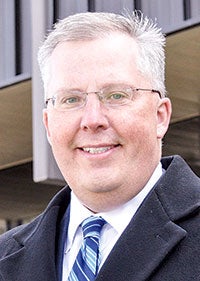City leaders attend Legislative Action Day; LGA increase, clean water infrastructure bonding bill among major items
Published 6:24 am Tuesday, February 5, 2019
An increase in Local Government Aid (LGA) and bonding bill money for a septic system upgrade were among the main topics city leaders discussed with lawmakers during Legislative Action Day in St. Paul last week.
Austin Mayor Tom Stiehm and City Administrator Craig Clark joined other members of the Coalition of Greater Minnesota Cities (CGMC) in lobbying state leaders on issues relevant to their respective areas.
“We got good news that (Gov. Walz) intends to put (LGA) in his budget at the 2002 levels and try to keep us current with added inflationary increases and continue the partnership with the state,” Clark said.
A $30.5 million increase would be needed to bring LGA back to its 2002 high-water mark. According to the CGMC, state spending has increased by 65 percent since 2003, while LGA has fallen by more than five percent.
Many cities in Greater Minnesota have small tax bases, making them more dependent on LGA to help with handling financial pressures. Gov. Walz attended meetings with the CGMC and assured them that an increase in LGA will be a priority in his budget.
“LGA will be increased to the city of Austin by just less than $300,000 and we very much appreciate Gov. Walz recognizing the importance of LGA and the recognition of the importance that cities play in delivering services to Minnesotans,” Clark said.
City leaders also lobbied for the passage of a bonding bill that would provide funds for clean water infrastructure.
According to Clark, Rep. Jeanne Poppe (D-27B) has agreed to be the chief author of House File 411, a bill that would fully fund approximately $128 million needed for clean water infrastructure projects throughout the state. Two million dollars of that would go toward the Turtle Creek II sewer extension project to connect 40 homes to the city sewer service and protect ground and surface water from contamination from a failing septic system that is directly discharging into surface water. The homes are on property annexed by the city in 2014.

City Administrator Craig Clark
“That area has been on the bubble,” Clark said. “They could have dealt with environmental concerns by adding a septic system onsite or connect to city services. Residents chose to connect to city services, but it was conditioned on receiving a state grant of 80 percent of the cost share of the project coming from the state. Without the grant, the project doesn’t move forward. Through assessments on the individual homeowners and the state grant dollars, we’re hopeful we can get the project completed and protect the environment.”
The bill is intended to get funding for the projects this year after environmental groups filed a lawsuit contesting other sources of funding proposed by legislative Republicans.
Clark said city leaders are hoping for an early passage.
“I think there is (a good chance it will pass),” he said. “It’s more of a matter when in the session. We’re not interested in getting it mired down in a constitutional challenge on the funding source. That question predominately lies with the Senate and seeing how they take it up. Senate Majority Leader (Paul) Gazelka has a ($22 million plant upgrade) project in Little Falls, so we’re hopeful he’ll want to see a solution to that and move quickly and not get bogged down in the legislative process at the 11th hour of the session.”
Clark confirmed other measures that may help are in consideration, saying the city supports “any solution that provides the financial resources to get the projects moving.”
As House File 411 moves forward, city leaders hope to have more input.
“There will be more hearings on it and we hope to attend those and give Austin’s perspective on what it means to this area that has been annexed,” Clark said. “Other communities have compelling stories as well, but we certainly will join in sharing our stories with legislators. There are imminent public health threats in some of the systems to both surface and groundwater. It’s serious and not something we want to sweep under the rug.”




